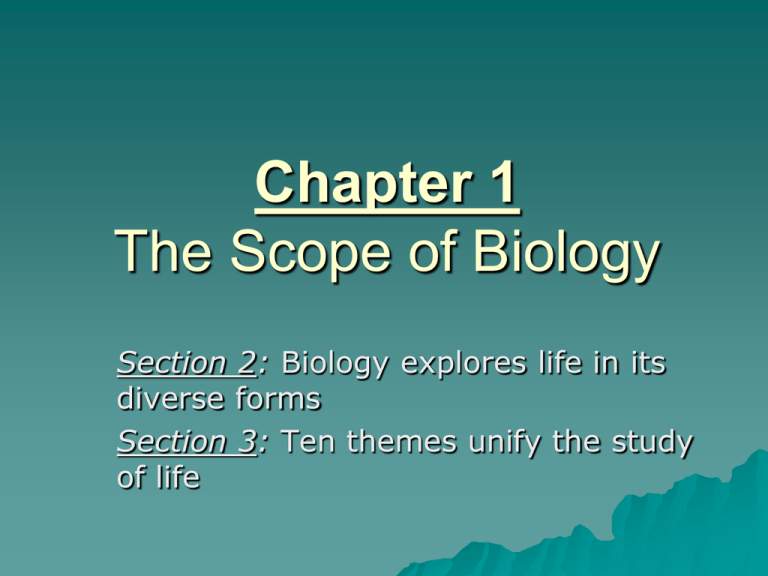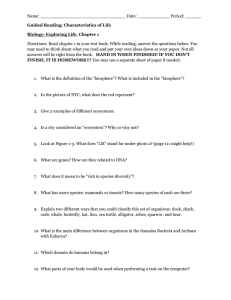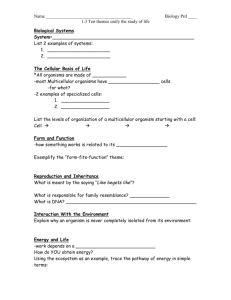Chapter 1 – The Scope of Biology
advertisement

Chapter 1 The Scope of Biology Section 2: Biology explores life in its diverse forms Section 3: Ten themes unify the study of life Life’s Diversity of Species The earth is full of a diverse # of plants and animals. Each different kind of organism is an example of a different species. – Definition: distinct form of life Classifying Life Into Domains In classifying, we call the largest category a domain. – Definition: broadest category used to classify life forms Three main domains DOMAIN ARCHAEA, DOMAIN BACTERIA and DOMAIN EUKARYA DOMAIN EUKARYA is broken down into 4 sub categories Kingdom Protista, Kingdom Fungi, Kingdom Plantae, Kingdom Animalia Three Domains of Life Archaea Bacteria Eukarya Very tiny Unicellular Lack nuclei Prokaryotic Very tiny Unicellular Lack nuclei Prokaryotic Includes: protists, fungi, plants, and animals Multicellular Contain nuclei Eukaryotic Chapter 1 The Scope of Biology Section 2: Biology explores life in its diverse forms Section 3: Ten themes unify the study of life Biological Systems Two main types of biological systems – Your body and the body of all living beings (organisms) is made up of different systems working together and interacting with each other. – An ecosystem has properties that depend on how its parts interact. The Cellular Basis of Life ALL ORGANISMS ARE MADE UP OF CELLS Single cell Tissue Organ Organ System Form and Function How something works is related to its structure form fits function Reproduction and Inheritance Each species will recreate offspring with members within it’s own species Genes are responsible for the passing on of traits and physical characteristics Genes are found within the DNA of each cell Interaction With the Environment As part of an ecosystem, each organism interacts continuously with its environment. Photosynthesis: process by which the plants use the sun’s energy to convert water and carbon dioxide into sugars Energy and Life All of life’s functions require the use of energy Energy is found all around us and within our bodies and environments. Photosynthesis plants convert light energy to chemical energy stored in sugars and other foods. – Plants are examples of producers. Definition: organism that makes its own food (autotroph) and produces organic molecules that serve as food for other organisms in its ecosystem – Organisms that feed on the producers are called consumers. Definition: organism that obtains food by eating producers and other consumers Regulation Regulation is the ability of organisms to regulate their internal conditions. When the internal environment of an organisms is in a “steady state” despite changes in the external environment, the body is said to be in homeostasis. – EXAMPLE: if your internal “thermostat” in your brain detects a slight rise in body temperature on a hot day, your brain signals your skin to produce sweat – sweating helps cool your body. Adaptation and Evolution Adaptations are found throughout generations of species. Definition: inherited characteristic that improves an organism’s ability to survive and reproduce in a particular environment Organisms adapt to their environments because of the variation among individuals is a population. Definition: group of individuals of the same species living in a particular area at the same time – If a particular variation is helpful, individual with the variation may live longer and produce more offspring than those that do not have it. (this is called natural selection) Natural selection is the mechanism by which evolution occurs. Definition: generation-to-generation change in the proportion of different inherited genes in a population that account for all of the changes that have transformed life over an immense time Biology and Society The application of biology in society has made major impacts on daily life. – EXAMPLES: research on the nervous system is improving the treatment of some mental illnesses, water and air pollution are changing the way people thing about their relationship to the biosphere, etc. Scientific Inquiry Scientists (over many years) have asked questions about the natural world. – These questions have led us to the knowledge we have today and continue to inspire us to solve what we do not know.







